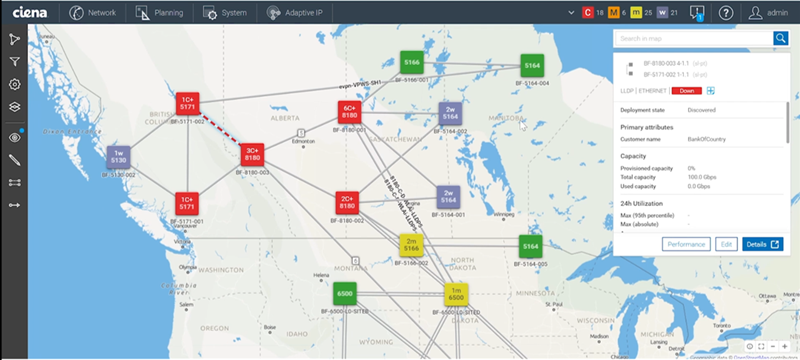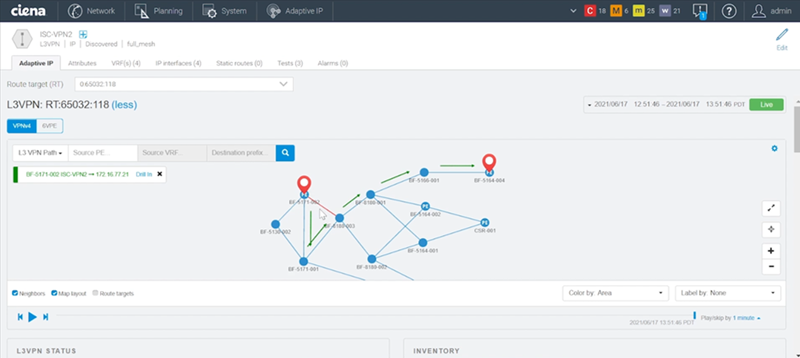Adaptive IP Apps to the rescue
IP networks were designed to be extremely dynamic, with a variety of IP routing protocols enabling quick and resilient rerouting of IP traffic during failure scenarios. That’s all well and good, except when you’re trying to diagnose a past fault and replay the network behavior, to get to the root cause and avoid another such fault in the future. Then things get very complicated and time-consuming. An issue from which you expect to recover in one hour, may actually take much longer – over six hours!
Service providers are struggling with the challenge of delivering the best quality digital experience to their customers – whether they are providing wholesale connectivity to other operators such as Mobile Network Operators (MNOs), cloud access for enterprises and education, or high-bandwidth residential services. IP network architectures are also evolving, expanding and moving closer to the edge to support low-latency, high-bandwidth services more efficiently with Edge Cloud (distributed compute and storage at edge data centers with high-capacity coherent optics connectivity into the core). There is also densification of IP endpoints as 5G cell sites roll out to provide increased coverage. To deal with this scalability and unpredictability in traffic patterns, operators are seeking to optimize IP network operations.
Given the prevalence of IP technology, and its evolution over the past decades, existing networks are typically comprised of routers from different vendors, each having separate network management systems (NMS). So, network operations center (NOC) personnel need to manually correlate data from multiple NMS’ in order to gain insight into overall network behavior and diagnose any performance issues that may arise. What’s needed is comprehensive vendor-agnostic visibility and advanced analytics to help accelerate repetitive, time-consuming operational tasks such as network troubleshooting and IP traffic engineering (TE). The end vision is to achieve automation in order to increase service velocity.
Ciena’s innovative Adaptive IPTM Apps does just that by collecting extensive data from multi-vendor IP devices and presenting IP/MPLS analytics intuitively so that service providers know exactly how their network is performing—at all times. They can even roll back time to diagnose past issues.
The killer app at work: Three real-world use cases
Service providers, like WIN Technology in the US Midwest, are making the move to automate IP operations by leveraging Ciena’s Adaptive IP Apps for the benefit of their enterprise customers. With advanced visualization and real-time analysis capabilities, WIN Technology is able to dramatically reduce the time required to diagnose and resolve any issues that arise.

Comprehensive network view with quick access to alarm details example
Another service provider customer is building out a new IP core network that is high-speed, adaptive, and future-proof and have thus chosen Adaptive IP Apps to help ensure that they will be able to meet the strict latency and availability requirements for advanced Enterprise services and wholesale 5G xhaul. With the Ciena solution, they gain multi-vendor IP network topology visualization and real-time monitoring of the network control plane and overlay services so that they can take proactive measures for service assurance, instead of only reacting to unexpected faults. In addition, they benefit from Adaptive IP Apps’ automated path computation engine (PCE) for configuration of TE tunnels, to optimize traffic and relieve potential congestion.
For another service provider, a major outage that brought down connectivity for thousands of customers was the compelling reason they turned to Ciena for our Adaptive IP Apps capabilities. The operations team was certain they could have significantly reduced the customer impact of the network misbehavior, had they been able to see IP network performance data in real-time and quickly isolate the faulty network elements, and work around the trouble. By correlating traffic flow records with routing data for path-aware, service-aware traffic analytics, Adaptive IP Apps will now give the NOC needed key performance indicators (KPIs) across their multi-vendor network so they can playback network behavior and diagnose issues quickly, before they cause a network-wide outage. They will also be able to proactively explore the impact of different failure scenarios and engineer their network to mitigate such impacts.

Real-time visualization of IP route topology and analytics, with playback functionality
Service providers may be coming at the solution from different perspectives, but whatever the situation, one thing is clear: high IP network performance and reliability is not optional and we’ve got the killer app to help make it happen.








